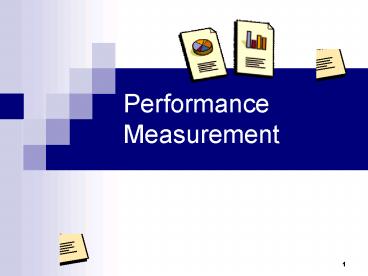Performance Measurement
1 / 21
Title: Performance Measurement
1
Performance Measurement
2
Remember a budgeting has three perspectives
- Planning Function
- Set up short-term goal develop budget
- Performance Measurement
- Controlling Function
3
Comparing Actual Results to Planned Results
- Budget Comparison and Variance Analysis
4
Two sides of coin
- We can just plan
- But if we have a plan we can use it to control
operations - A plan that isnt used to evaluate performance is
a wasted effort
Planning
Control
5
Performance Measurement Comparing to Budget
- The starting point for control performance
measurement is to compare actual outcomes to the
plan - There could be various types of comparisons
- Master budget
- Flexible budget
- Standard budget
6
Budget Target
- On a regular basis, actual performance should be
compared to the budget - Identify problems so that they can be resolved
quickly - Sometimes the budget assumptions were wrong and
the budget rather than performance might be the
problem - REVISE BUDGET!
7
Flexibility is necessary
- Most budgets are out-of-date within the first
month as unforeseen events occur - This might be one reason to consider rolling
budgets an ongoing revision process - Always having 12 months of budgets ahead of you
instead of a once a year process - Rolling forecasts is another name for the same
thing
8
Static vs. Flexible Budget
- Budget comparisons and variances
9
Static (Master) Budget
- It is called Master Budget
- Budgeted revenues and budgeted costs based on the
level of output planned at the start of the
budget period. - Actual Performance is compared to Static Budget
10
Example of Static Budget Comparison Report
- Budget assumptions
- 20 per unit sales price
- 10 per unit variable costs
- Anticipated sales 1,000 units per month
- Fixed costs 3,000 per month
- Actual sales were 1,200 units at 18 each and the
variable costs were 9.5 each? Actual fixed cost
3,300
11
Example of Static Budget Comparison Report
12
Flexible Budget
- This is the budget we would have prepared HAD WE
ONLY KNOWN the number of units that would be sold
or produced. - Remember that budget needs information about
- Sales price
- Sales volume
- Product costs
Flexible budget assumes that the actual sales
volume is given.
13
Flexible Budget
- Given the number of products to be sold
(produced), F/B needs to know assumptions of - Expected selling price per unit
- Variable cost per unit
- Fixed costs (in total)
14
Example of Flexible Budget
- Budget assumptions
- 20 per unit sales price
- 10 per unit variable costs
- Anticipated sales 1,000 units per month
- Fixed costs 3,000 per month
- Actual sales were 1,200 units at 18 each and the
variable costs were 9.5 each? Actual fixed cost
3,300
15
Flexible Budget Example
16
Compared to original budget
- Note that if we did our budget comparison based
on the original sales level (Master budget), the
department looks good when it really wasnt on
target
17
We can further analyze the variances
- Sales VOLUME variance
- Variance caused by selling more or less than
planned - Formula (actual units planned units)
planned selling price per unit - Another definition Difference between master
budget and flexible budget
18
We can further analyze the variances
- Sales PRICE variance
- Variance caused when sales price per unit is
different than we planned - Formula(actual unit price budgeted unit
price) units sold - Alternate definition Difference between flexible
budget and actual
19
Sales revenue variances
20
Our example
21
Easier than formulas?
- Sales volume variance
- (actual units planned units) planned selling
price per unit - Sales price variance
- (actual unit price budgeted unit price) units
sold
Note Some companies use contribution margin per
unit instead of selling price to compute these
variances.
22
Exercise Problem
FX produces luxury check books. Following is
information of operating budget and actual
results.
Q1. Calculate variances in sales, variable and
fixed costs under master budget. Q2. Calculate Q1
under flexible budget. (Do quantity, price
variance analysis).































